Organisational Behaviour Report: Unit 12, Marks & Spencer Analysis
VerifiedAdded on 2023/01/19
|20
|5905
|42
Report
AI Summary
This report provides a comprehensive analysis of organisational behaviour, focusing on Marks & Spencer as a case study. It explores the influence of organisational culture, power dynamics, and politics on individual and team behaviour and performance. The report delves into various motivational theories, such as Maslow's hierarchy of needs and Vroom's expectancy theory, examining their practical applications in influencing employee behaviour. It also differentiates between effective and ineffective teams, analyzing relevant team development theories. Furthermore, the report evaluates key concepts and philosophies of organisational behaviour, offering insights into how these elements contribute to organisational success and problem-solving. The report provides a detailed understanding of how these factors impact organisational success and employee behaviour, offering valuable insights for effective leadership and management practices within the context of Marks & Spencer.
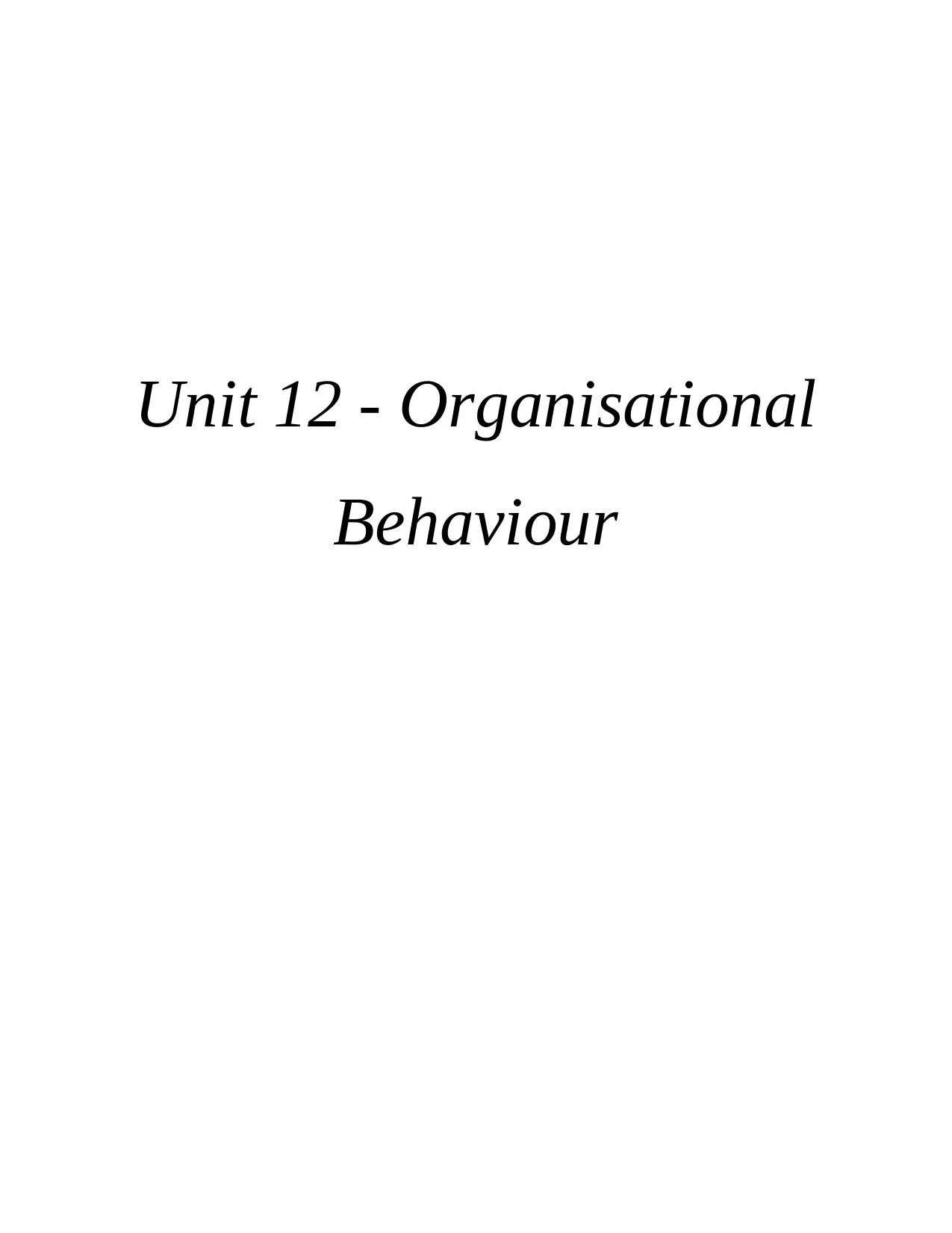
Unit 12 - Organisational
Behaviour
Behaviour
Paraphrase This Document
Need a fresh take? Get an instant paraphrase of this document with our AI Paraphraser
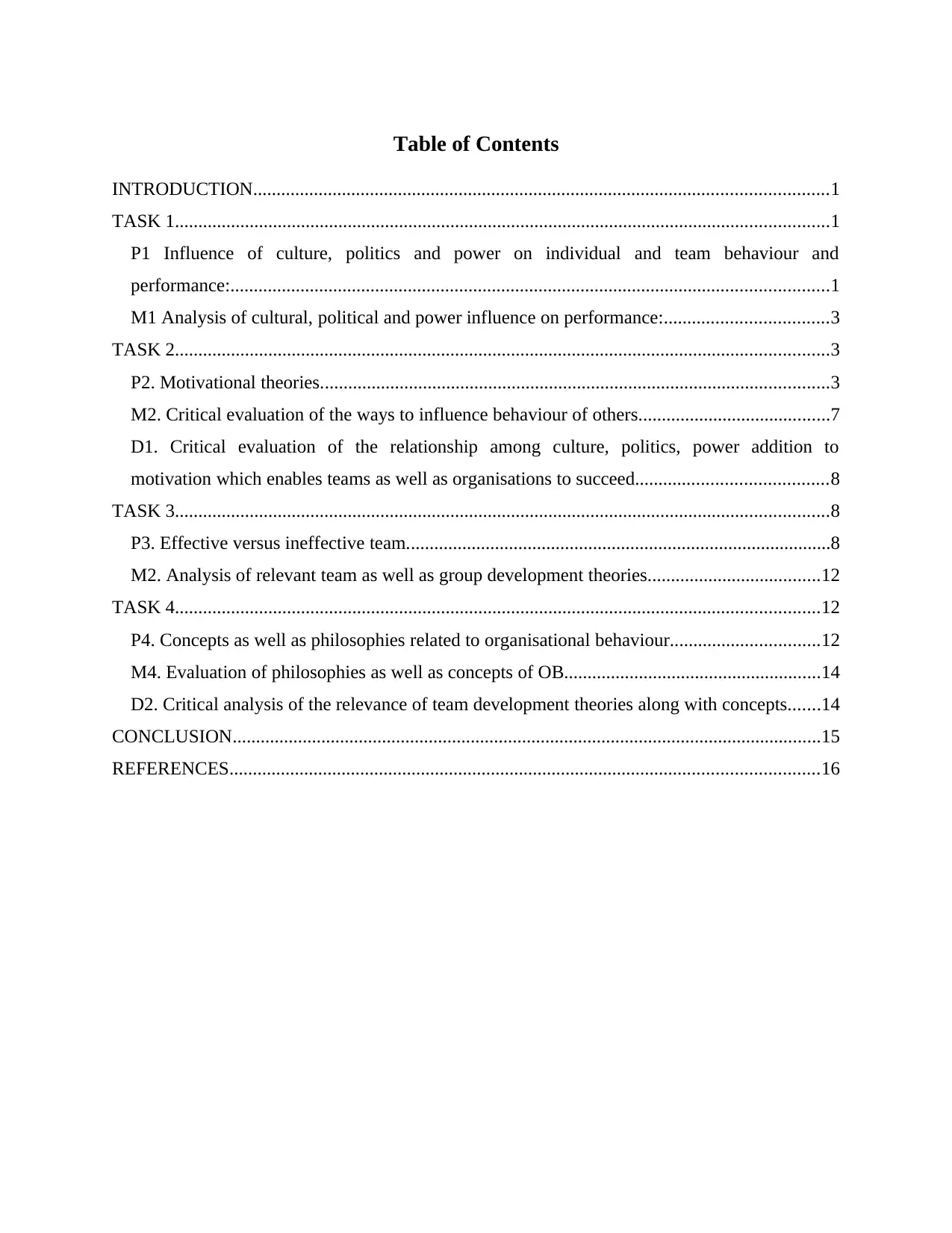
Table of Contents
INTRODUCTION...........................................................................................................................1
TASK 1............................................................................................................................................1
P1 Influence of culture, politics and power on individual and team behaviour and
performance:................................................................................................................................1
M1 Analysis of cultural, political and power influence on performance:...................................3
TASK 2............................................................................................................................................3
P2. Motivational theories.............................................................................................................3
M2. Critical evaluation of the ways to influence behaviour of others.........................................7
D1. Critical evaluation of the relationship among culture, politics, power addition to
motivation which enables teams as well as organisations to succeed.........................................8
TASK 3............................................................................................................................................8
P3. Effective versus ineffective team...........................................................................................8
M2. Analysis of relevant team as well as group development theories.....................................12
TASK 4..........................................................................................................................................12
P4. Concepts as well as philosophies related to organisational behaviour................................12
M4. Evaluation of philosophies as well as concepts of OB.......................................................14
D2. Critical analysis of the relevance of team development theories along with concepts.......14
CONCLUSION..............................................................................................................................15
REFERENCES..............................................................................................................................16
INTRODUCTION...........................................................................................................................1
TASK 1............................................................................................................................................1
P1 Influence of culture, politics and power on individual and team behaviour and
performance:................................................................................................................................1
M1 Analysis of cultural, political and power influence on performance:...................................3
TASK 2............................................................................................................................................3
P2. Motivational theories.............................................................................................................3
M2. Critical evaluation of the ways to influence behaviour of others.........................................7
D1. Critical evaluation of the relationship among culture, politics, power addition to
motivation which enables teams as well as organisations to succeed.........................................8
TASK 3............................................................................................................................................8
P3. Effective versus ineffective team...........................................................................................8
M2. Analysis of relevant team as well as group development theories.....................................12
TASK 4..........................................................................................................................................12
P4. Concepts as well as philosophies related to organisational behaviour................................12
M4. Evaluation of philosophies as well as concepts of OB.......................................................14
D2. Critical analysis of the relevance of team development theories along with concepts.......14
CONCLUSION..............................................................................................................................15
REFERENCES..............................................................................................................................16

INTRODUCTION
Organizational behaviour can be described as a study of understanding and managing
human behaviour within the organizational environment (Axelsson and Easton, 2016). It helps in
identify the nature of the employees and create an effective interrelation and communication
among them that is extremely important for improving the organizational performance and
operations. A detailed examination of organizational behaviour also helps in understanding and
implementing adequate leadership style that is a significant factor to manage and motivate the
workforce. The present assessment is based on Marks & Spencer which is among the
multinational retailer, specialised in selling eatable commodities, clothing addition to household
products.
This report will develop an understanding of organizational behaviour, culture, power
and politics. It will also cover some motivational theories that will help the leaders to motivate
individuals and develop an understanding to co-operate with others effectively. The report will
also present some concepts and philosophies of organizational behaviour to solve organizational
problems and cope up with tough situations.
TASK 1
P1 Influence of culture, politics and power on individual and team behaviour and performance:
Organizational culture: Organizational culture can be defined as a set of aggregate
beliefs and principles that are responsible to design the structure of the behaviour of employees.
There is always a direct link between organizational performance and culture as cultural values
that depends upon the firms strategies that is the key of organizational success (Balint, 2018).
There are several cultures that influence the organization are presented below:
Role Culture: A role culture is that in which an effective organizational structure has
been created, employees are aware about their roles and responsibilities and report to their
superior management and above all of them, value accuracy and efficiency is essential. Hence,
when managers of Marks & Spencer adopts such culture they creates extremely structures and
stable establishments.
Power culture: In power culture, all the power and authorities are in the hand of a group
of few people or an individual who make rapid decisions and have a strong control over
strategies and activities. The centre of the power is generally the owner of the organization. This
1
Organizational behaviour can be described as a study of understanding and managing
human behaviour within the organizational environment (Axelsson and Easton, 2016). It helps in
identify the nature of the employees and create an effective interrelation and communication
among them that is extremely important for improving the organizational performance and
operations. A detailed examination of organizational behaviour also helps in understanding and
implementing adequate leadership style that is a significant factor to manage and motivate the
workforce. The present assessment is based on Marks & Spencer which is among the
multinational retailer, specialised in selling eatable commodities, clothing addition to household
products.
This report will develop an understanding of organizational behaviour, culture, power
and politics. It will also cover some motivational theories that will help the leaders to motivate
individuals and develop an understanding to co-operate with others effectively. The report will
also present some concepts and philosophies of organizational behaviour to solve organizational
problems and cope up with tough situations.
TASK 1
P1 Influence of culture, politics and power on individual and team behaviour and performance:
Organizational culture: Organizational culture can be defined as a set of aggregate
beliefs and principles that are responsible to design the structure of the behaviour of employees.
There is always a direct link between organizational performance and culture as cultural values
that depends upon the firms strategies that is the key of organizational success (Balint, 2018).
There are several cultures that influence the organization are presented below:
Role Culture: A role culture is that in which an effective organizational structure has
been created, employees are aware about their roles and responsibilities and report to their
superior management and above all of them, value accuracy and efficiency is essential. Hence,
when managers of Marks & Spencer adopts such culture they creates extremely structures and
stable establishments.
Power culture: In power culture, all the power and authorities are in the hand of a group
of few people or an individual who make rapid decisions and have a strong control over
strategies and activities. The centre of the power is generally the owner of the organization. This
1
⊘ This is a preview!⊘
Do you want full access?
Subscribe today to unlock all pages.

Trusted by 1+ million students worldwide
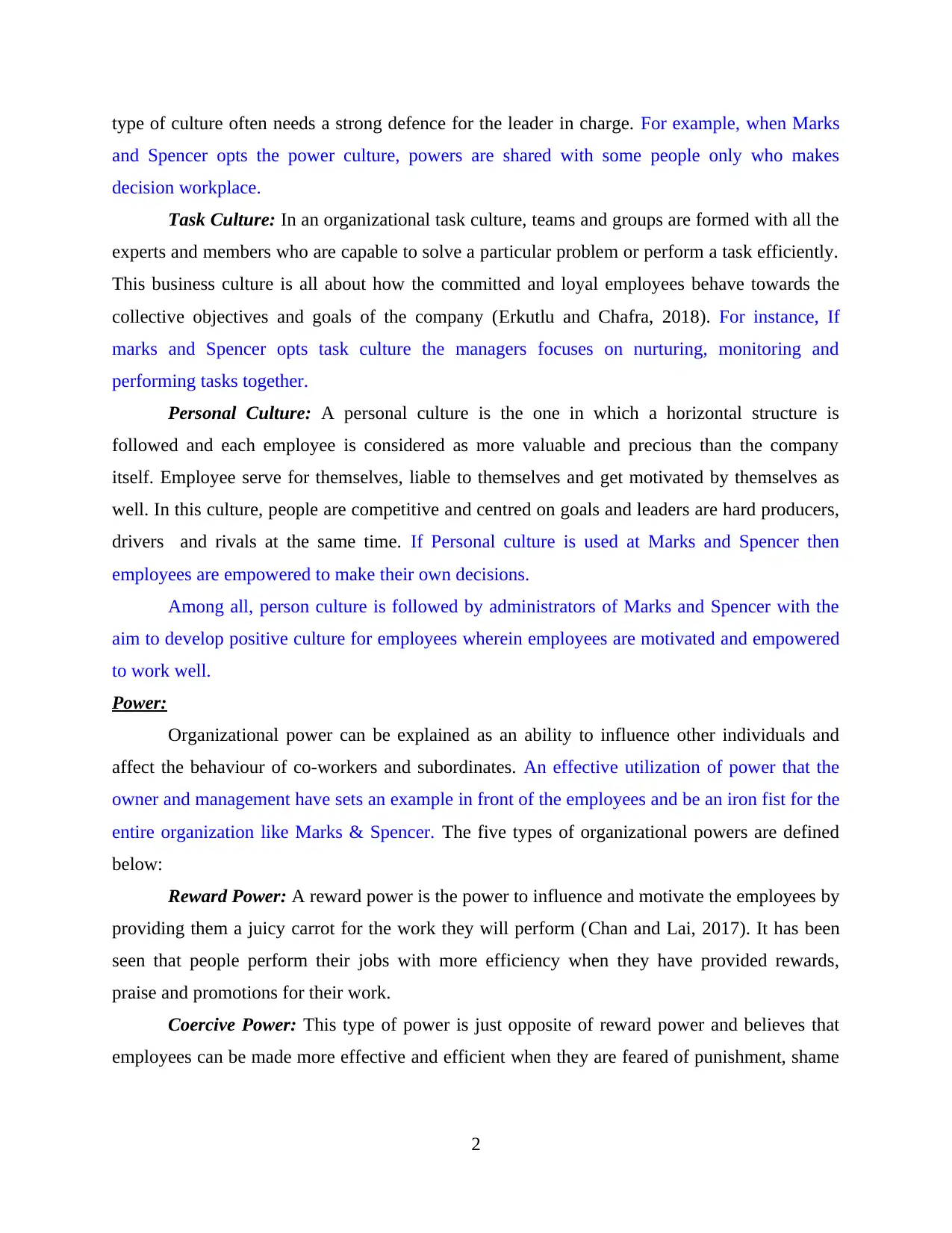
type of culture often needs a strong defence for the leader in charge. For example, when Marks
and Spencer opts the power culture, powers are shared with some people only who makes
decision workplace.
Task Culture: In an organizational task culture, teams and groups are formed with all the
experts and members who are capable to solve a particular problem or perform a task efficiently.
This business culture is all about how the committed and loyal employees behave towards the
collective objectives and goals of the company (Erkutlu and Chafra, 2018). For instance, If
marks and Spencer opts task culture the managers focuses on nurturing, monitoring and
performing tasks together.
Personal Culture: A personal culture is the one in which a horizontal structure is
followed and each employee is considered as more valuable and precious than the company
itself. Employee serve for themselves, liable to themselves and get motivated by themselves as
well. In this culture, people are competitive and centred on goals and leaders are hard producers,
drivers and rivals at the same time. If Personal culture is used at Marks and Spencer then
employees are empowered to make their own decisions.
Among all, person culture is followed by administrators of Marks and Spencer with the
aim to develop positive culture for employees wherein employees are motivated and empowered
to work well.
Power:
Organizational power can be explained as an ability to influence other individuals and
affect the behaviour of co-workers and subordinates. An effective utilization of power that the
owner and management have sets an example in front of the employees and be an iron fist for the
entire organization like Marks & Spencer. The five types of organizational powers are defined
below:
Reward Power: A reward power is the power to influence and motivate the employees by
providing them a juicy carrot for the work they will perform (Chan and Lai, 2017). It has been
seen that people perform their jobs with more efficiency when they have provided rewards,
praise and promotions for their work.
Coercive Power: This type of power is just opposite of reward power and believes that
employees can be made more effective and efficient when they are feared of punishment, shame
2
and Spencer opts the power culture, powers are shared with some people only who makes
decision workplace.
Task Culture: In an organizational task culture, teams and groups are formed with all the
experts and members who are capable to solve a particular problem or perform a task efficiently.
This business culture is all about how the committed and loyal employees behave towards the
collective objectives and goals of the company (Erkutlu and Chafra, 2018). For instance, If
marks and Spencer opts task culture the managers focuses on nurturing, monitoring and
performing tasks together.
Personal Culture: A personal culture is the one in which a horizontal structure is
followed and each employee is considered as more valuable and precious than the company
itself. Employee serve for themselves, liable to themselves and get motivated by themselves as
well. In this culture, people are competitive and centred on goals and leaders are hard producers,
drivers and rivals at the same time. If Personal culture is used at Marks and Spencer then
employees are empowered to make their own decisions.
Among all, person culture is followed by administrators of Marks and Spencer with the
aim to develop positive culture for employees wherein employees are motivated and empowered
to work well.
Power:
Organizational power can be explained as an ability to influence other individuals and
affect the behaviour of co-workers and subordinates. An effective utilization of power that the
owner and management have sets an example in front of the employees and be an iron fist for the
entire organization like Marks & Spencer. The five types of organizational powers are defined
below:
Reward Power: A reward power is the power to influence and motivate the employees by
providing them a juicy carrot for the work they will perform (Chan and Lai, 2017). It has been
seen that people perform their jobs with more efficiency when they have provided rewards,
praise and promotions for their work.
Coercive Power: This type of power is just opposite of reward power and believes that
employees can be made more effective and efficient when they are feared of punishment, shame
2
Paraphrase This Document
Need a fresh take? Get an instant paraphrase of this document with our AI Paraphraser
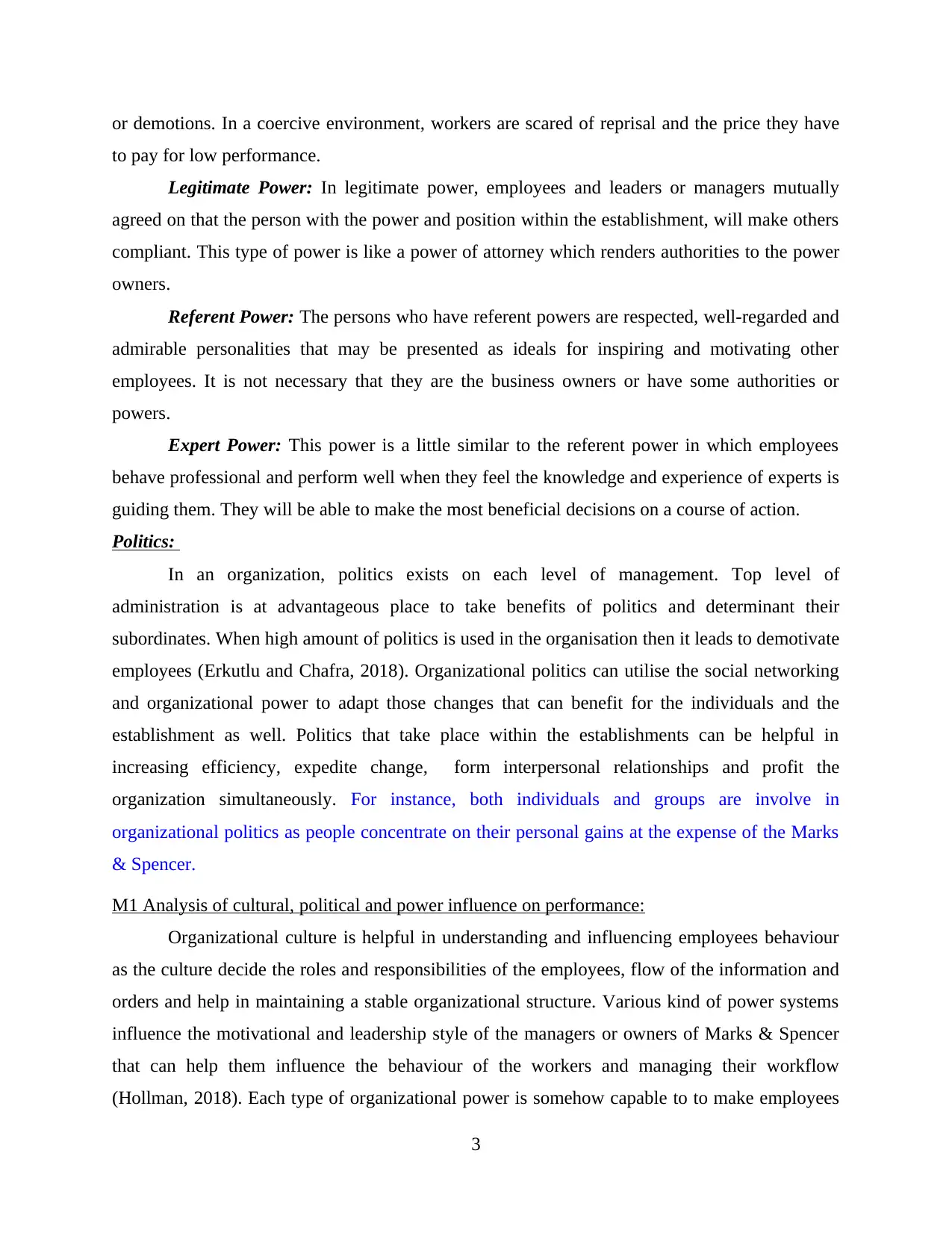
or demotions. In a coercive environment, workers are scared of reprisal and the price they have
to pay for low performance.
Legitimate Power: In legitimate power, employees and leaders or managers mutually
agreed on that the person with the power and position within the establishment, will make others
compliant. This type of power is like a power of attorney which renders authorities to the power
owners.
Referent Power: The persons who have referent powers are respected, well-regarded and
admirable personalities that may be presented as ideals for inspiring and motivating other
employees. It is not necessary that they are the business owners or have some authorities or
powers.
Expert Power: This power is a little similar to the referent power in which employees
behave professional and perform well when they feel the knowledge and experience of experts is
guiding them. They will be able to make the most beneficial decisions on a course of action.
Politics:
In an organization, politics exists on each level of management. Top level of
administration is at advantageous place to take benefits of politics and determinant their
subordinates. When high amount of politics is used in the organisation then it leads to demotivate
employees (Erkutlu and Chafra, 2018). Organizational politics can utilise the social networking
and organizational power to adapt those changes that can benefit for the individuals and the
establishment as well. Politics that take place within the establishments can be helpful in
increasing efficiency, expedite change, form interpersonal relationships and profit the
organization simultaneously. For instance, both individuals and groups are involve in
organizational politics as people concentrate on their personal gains at the expense of the Marks
& Spencer.
M1 Analysis of cultural, political and power influence on performance:
Organizational culture is helpful in understanding and influencing employees behaviour
as the culture decide the roles and responsibilities of the employees, flow of the information and
orders and help in maintaining a stable organizational structure. Various kind of power systems
influence the motivational and leadership style of the managers or owners of Marks & Spencer
that can help them influence the behaviour of the workers and managing their workflow
(Hollman, 2018). Each type of organizational power is somehow capable to to make employees
3
to pay for low performance.
Legitimate Power: In legitimate power, employees and leaders or managers mutually
agreed on that the person with the power and position within the establishment, will make others
compliant. This type of power is like a power of attorney which renders authorities to the power
owners.
Referent Power: The persons who have referent powers are respected, well-regarded and
admirable personalities that may be presented as ideals for inspiring and motivating other
employees. It is not necessary that they are the business owners or have some authorities or
powers.
Expert Power: This power is a little similar to the referent power in which employees
behave professional and perform well when they feel the knowledge and experience of experts is
guiding them. They will be able to make the most beneficial decisions on a course of action.
Politics:
In an organization, politics exists on each level of management. Top level of
administration is at advantageous place to take benefits of politics and determinant their
subordinates. When high amount of politics is used in the organisation then it leads to demotivate
employees (Erkutlu and Chafra, 2018). Organizational politics can utilise the social networking
and organizational power to adapt those changes that can benefit for the individuals and the
establishment as well. Politics that take place within the establishments can be helpful in
increasing efficiency, expedite change, form interpersonal relationships and profit the
organization simultaneously. For instance, both individuals and groups are involve in
organizational politics as people concentrate on their personal gains at the expense of the Marks
& Spencer.
M1 Analysis of cultural, political and power influence on performance:
Organizational culture is helpful in understanding and influencing employees behaviour
as the culture decide the roles and responsibilities of the employees, flow of the information and
orders and help in maintaining a stable organizational structure. Various kind of power systems
influence the motivational and leadership style of the managers or owners of Marks & Spencer
that can help them influence the behaviour of the workers and managing their workflow
(Hollman, 2018). Each type of organizational power is somehow capable to to make employees
3
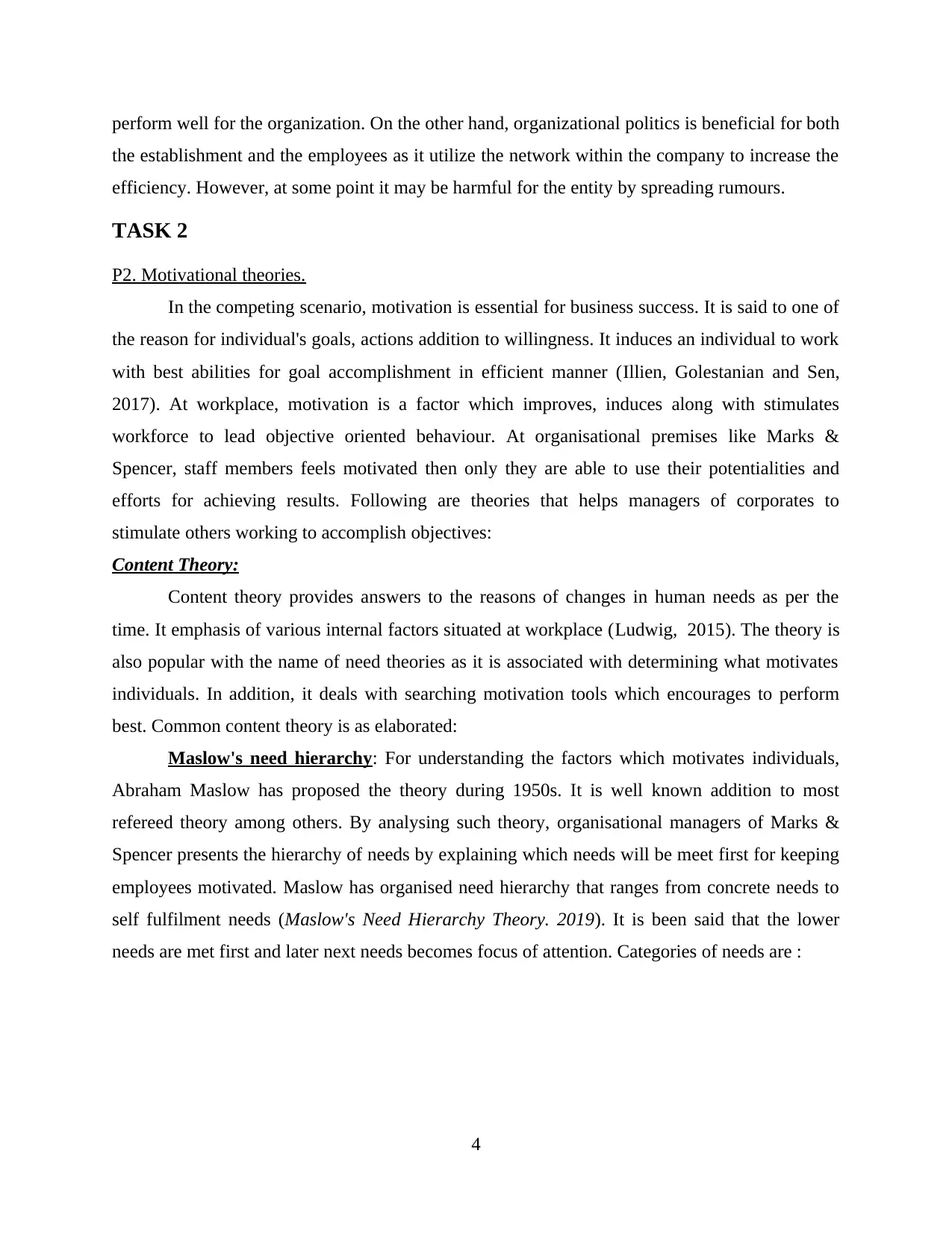
perform well for the organization. On the other hand, organizational politics is beneficial for both
the establishment and the employees as it utilize the network within the company to increase the
efficiency. However, at some point it may be harmful for the entity by spreading rumours.
TASK 2
P2. Motivational theories.
In the competing scenario, motivation is essential for business success. It is said to one of
the reason for individual's goals, actions addition to willingness. It induces an individual to work
with best abilities for goal accomplishment in efficient manner (Illien, Golestanian and Sen,
2017). At workplace, motivation is a factor which improves, induces along with stimulates
workforce to lead objective oriented behaviour. At organisational premises like Marks &
Spencer, staff members feels motivated then only they are able to use their potentialities and
efforts for achieving results. Following are theories that helps managers of corporates to
stimulate others working to accomplish objectives:
Content Theory:
Content theory provides answers to the reasons of changes in human needs as per the
time. It emphasis of various internal factors situated at workplace (Ludwig, 2015). The theory is
also popular with the name of need theories as it is associated with determining what motivates
individuals. In addition, it deals with searching motivation tools which encourages to perform
best. Common content theory is as elaborated:
Maslow's need hierarchy: For understanding the factors which motivates individuals,
Abraham Maslow has proposed the theory during 1950s. It is well known addition to most
refereed theory among others. By analysing such theory, organisational managers of Marks &
Spencer presents the hierarchy of needs by explaining which needs will be meet first for keeping
employees motivated. Maslow has organised need hierarchy that ranges from concrete needs to
self fulfilment needs (Maslow's Need Hierarchy Theory. 2019). It is been said that the lower
needs are met first and later next needs becomes focus of attention. Categories of needs are :
4
the establishment and the employees as it utilize the network within the company to increase the
efficiency. However, at some point it may be harmful for the entity by spreading rumours.
TASK 2
P2. Motivational theories.
In the competing scenario, motivation is essential for business success. It is said to one of
the reason for individual's goals, actions addition to willingness. It induces an individual to work
with best abilities for goal accomplishment in efficient manner (Illien, Golestanian and Sen,
2017). At workplace, motivation is a factor which improves, induces along with stimulates
workforce to lead objective oriented behaviour. At organisational premises like Marks &
Spencer, staff members feels motivated then only they are able to use their potentialities and
efforts for achieving results. Following are theories that helps managers of corporates to
stimulate others working to accomplish objectives:
Content Theory:
Content theory provides answers to the reasons of changes in human needs as per the
time. It emphasis of various internal factors situated at workplace (Ludwig, 2015). The theory is
also popular with the name of need theories as it is associated with determining what motivates
individuals. In addition, it deals with searching motivation tools which encourages to perform
best. Common content theory is as elaborated:
Maslow's need hierarchy: For understanding the factors which motivates individuals,
Abraham Maslow has proposed the theory during 1950s. It is well known addition to most
refereed theory among others. By analysing such theory, organisational managers of Marks &
Spencer presents the hierarchy of needs by explaining which needs will be meet first for keeping
employees motivated. Maslow has organised need hierarchy that ranges from concrete needs to
self fulfilment needs (Maslow's Need Hierarchy Theory. 2019). It is been said that the lower
needs are met first and later next needs becomes focus of attention. Categories of needs are :
4
⊘ This is a preview!⊘
Do you want full access?
Subscribe today to unlock all pages.

Trusted by 1+ million students worldwide
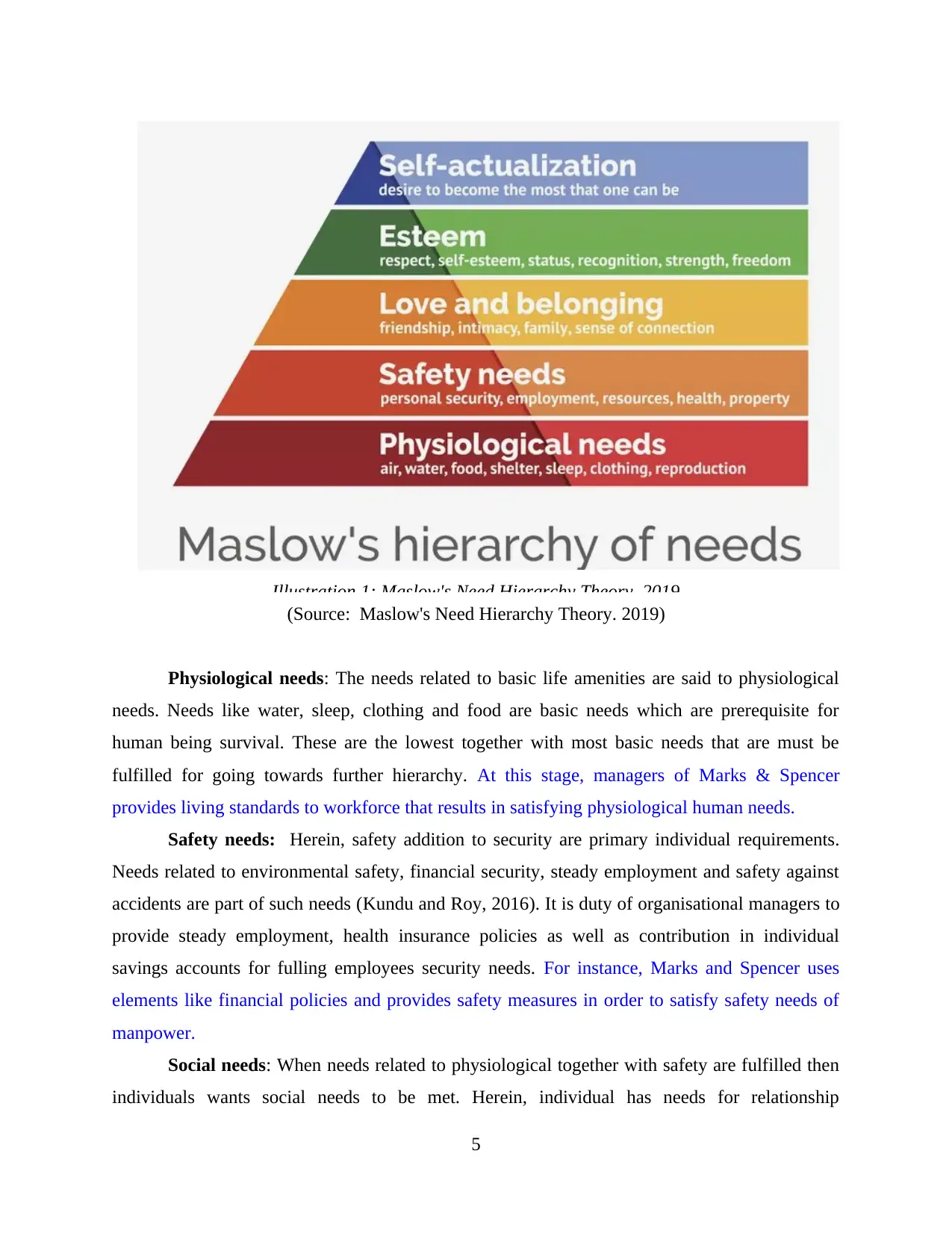
Illustration 1: Maslow's Need Hierarchy Theory. 2019
(Source: Maslow's Need Hierarchy Theory. 2019)
Physiological needs: The needs related to basic life amenities are said to physiological
needs. Needs like water, sleep, clothing and food are basic needs which are prerequisite for
human being survival. These are the lowest together with most basic needs that are must be
fulfilled for going towards further hierarchy. At this stage, managers of Marks & Spencer
provides living standards to workforce that results in satisfying physiological human needs.
Safety needs: Herein, safety addition to security are primary individual requirements.
Needs related to environmental safety, financial security, steady employment and safety against
accidents are part of such needs (Kundu and Roy, 2016). It is duty of organisational managers to
provide steady employment, health insurance policies as well as contribution in individual
savings accounts for fulling employees security needs. For instance, Marks and Spencer uses
elements like financial policies and provides safety measures in order to satisfy safety needs of
manpower.
Social needs: When needs related to physiological together with safety are fulfilled then
individuals wants social needs to be met. Herein, individual has needs for relationship
5
(Source: Maslow's Need Hierarchy Theory. 2019)
Physiological needs: The needs related to basic life amenities are said to physiological
needs. Needs like water, sleep, clothing and food are basic needs which are prerequisite for
human being survival. These are the lowest together with most basic needs that are must be
fulfilled for going towards further hierarchy. At this stage, managers of Marks & Spencer
provides living standards to workforce that results in satisfying physiological human needs.
Safety needs: Herein, safety addition to security are primary individual requirements.
Needs related to environmental safety, financial security, steady employment and safety against
accidents are part of such needs (Kundu and Roy, 2016). It is duty of organisational managers to
provide steady employment, health insurance policies as well as contribution in individual
savings accounts for fulling employees security needs. For instance, Marks and Spencer uses
elements like financial policies and provides safety measures in order to satisfy safety needs of
manpower.
Social needs: When needs related to physiological together with safety are fulfilled then
individuals wants social needs to be met. Herein, individual has needs for relationship
5
Paraphrase This Document
Need a fresh take? Get an instant paraphrase of this document with our AI Paraphraser
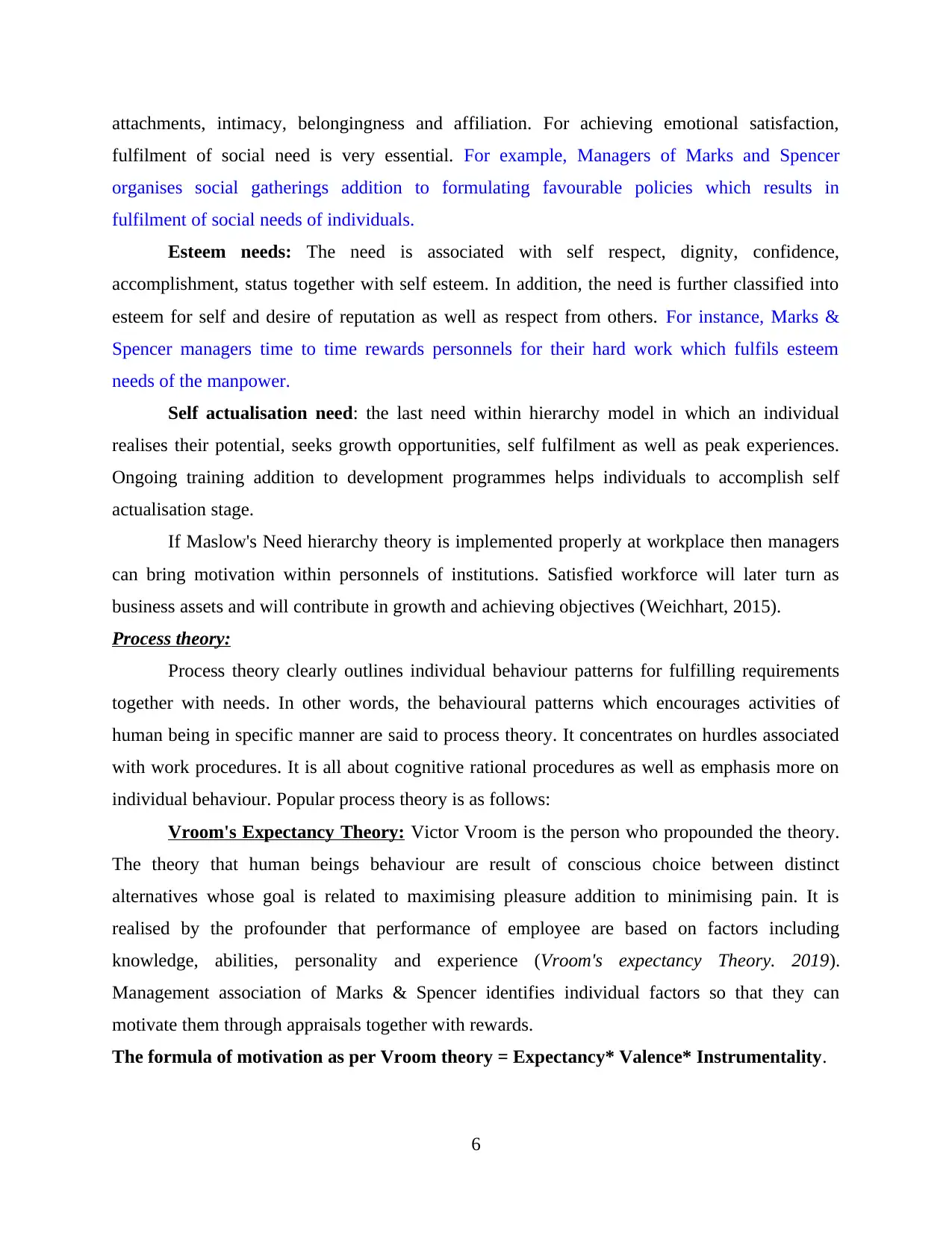
attachments, intimacy, belongingness and affiliation. For achieving emotional satisfaction,
fulfilment of social need is very essential. For example, Managers of Marks and Spencer
organises social gatherings addition to formulating favourable policies which results in
fulfilment of social needs of individuals.
Esteem needs: The need is associated with self respect, dignity, confidence,
accomplishment, status together with self esteem. In addition, the need is further classified into
esteem for self and desire of reputation as well as respect from others. For instance, Marks &
Spencer managers time to time rewards personnels for their hard work which fulfils esteem
needs of the manpower.
Self actualisation need: the last need within hierarchy model in which an individual
realises their potential, seeks growth opportunities, self fulfilment as well as peak experiences.
Ongoing training addition to development programmes helps individuals to accomplish self
actualisation stage.
If Maslow's Need hierarchy theory is implemented properly at workplace then managers
can bring motivation within personnels of institutions. Satisfied workforce will later turn as
business assets and will contribute in growth and achieving objectives (Weichhart, 2015).
Process theory:
Process theory clearly outlines individual behaviour patterns for fulfilling requirements
together with needs. In other words, the behavioural patterns which encourages activities of
human being in specific manner are said to process theory. It concentrates on hurdles associated
with work procedures. It is all about cognitive rational procedures as well as emphasis more on
individual behaviour. Popular process theory is as follows:
Vroom's Expectancy Theory: Victor Vroom is the person who propounded the theory.
The theory that human beings behaviour are result of conscious choice between distinct
alternatives whose goal is related to maximising pleasure addition to minimising pain. It is
realised by the profounder that performance of employee are based on factors including
knowledge, abilities, personality and experience (Vroom's expectancy Theory. 2019).
Management association of Marks & Spencer identifies individual factors so that they can
motivate them through appraisals together with rewards.
The formula of motivation as per Vroom theory = Expectancy* Valence* Instrumentality.
6
fulfilment of social need is very essential. For example, Managers of Marks and Spencer
organises social gatherings addition to formulating favourable policies which results in
fulfilment of social needs of individuals.
Esteem needs: The need is associated with self respect, dignity, confidence,
accomplishment, status together with self esteem. In addition, the need is further classified into
esteem for self and desire of reputation as well as respect from others. For instance, Marks &
Spencer managers time to time rewards personnels for their hard work which fulfils esteem
needs of the manpower.
Self actualisation need: the last need within hierarchy model in which an individual
realises their potential, seeks growth opportunities, self fulfilment as well as peak experiences.
Ongoing training addition to development programmes helps individuals to accomplish self
actualisation stage.
If Maslow's Need hierarchy theory is implemented properly at workplace then managers
can bring motivation within personnels of institutions. Satisfied workforce will later turn as
business assets and will contribute in growth and achieving objectives (Weichhart, 2015).
Process theory:
Process theory clearly outlines individual behaviour patterns for fulfilling requirements
together with needs. In other words, the behavioural patterns which encourages activities of
human being in specific manner are said to process theory. It concentrates on hurdles associated
with work procedures. It is all about cognitive rational procedures as well as emphasis more on
individual behaviour. Popular process theory is as follows:
Vroom's Expectancy Theory: Victor Vroom is the person who propounded the theory.
The theory that human beings behaviour are result of conscious choice between distinct
alternatives whose goal is related to maximising pleasure addition to minimising pain. It is
realised by the profounder that performance of employee are based on factors including
knowledge, abilities, personality and experience (Vroom's expectancy Theory. 2019).
Management association of Marks & Spencer identifies individual factors so that they can
motivate them through appraisals together with rewards.
The formula of motivation as per Vroom theory = Expectancy* Valence* Instrumentality.
6

Illustration 2: Vroom's expectancy Theory. 2019)
(Source: Vroom's expectancy Theory. 2019))
Expectancy: It is defined to the confidence as well as expectation level of individual
about the activities they are performing differs from other humans. Factors that affects
expectancy are requisite skills, acquiring accurate support that accomplishes allotted task and job
expertise (Memon and et.al., 2018). It is important for managers of Marks & Spencer to discover
the resources, supervisions addition to training to be provided to individuals for meeting
expectations.
Instrumentality: It is related to individual perception that if they perform better then will
achieve better outcome. Managers should ensure that promises made to staff members must be
fulfilled as well as employees should have knowledge about it. In context to Marks and Spencer,
Management associations of institutions delivers the rewards as per the promises that they have
made in past duartion.
Valence: The attraction degree possess by human beings as behavioural objective is
termed to valence. Rewards that managers presents in front of staff members for work
performances should be based on desires as well as expectations of employees. In context to
Marks and Spencer, Administrators deliver appraisals to workforce as per the values that each
individuals determines for workings.
7
(Source: Vroom's expectancy Theory. 2019))
Expectancy: It is defined to the confidence as well as expectation level of individual
about the activities they are performing differs from other humans. Factors that affects
expectancy are requisite skills, acquiring accurate support that accomplishes allotted task and job
expertise (Memon and et.al., 2018). It is important for managers of Marks & Spencer to discover
the resources, supervisions addition to training to be provided to individuals for meeting
expectations.
Instrumentality: It is related to individual perception that if they perform better then will
achieve better outcome. Managers should ensure that promises made to staff members must be
fulfilled as well as employees should have knowledge about it. In context to Marks and Spencer,
Management associations of institutions delivers the rewards as per the promises that they have
made in past duartion.
Valence: The attraction degree possess by human beings as behavioural objective is
termed to valence. Rewards that managers presents in front of staff members for work
performances should be based on desires as well as expectations of employees. In context to
Marks and Spencer, Administrators deliver appraisals to workforce as per the values that each
individuals determines for workings.
7
⊘ This is a preview!⊘
Do you want full access?
Subscribe today to unlock all pages.

Trusted by 1+ million students worldwide

The duration when organisational employees such as employees of Marks & Spencer
finds that the expectation level are met, they are encouraged to work in suitable productive
manner that leads towards attaining business goals in set time phase (Leberman and McDonald,
2016). Maslow's need hierarchy theory can be opted as motivation tool at any workplace so that
each personnel can be encourages or motivated to satisfy their needs or preferences.
Further, it is recommended to adopt policies associated with workplace improvement
practices, individual goal setting as well as positive reinforcement for improving motivation as
well as performances at workplace. For example, Workplace like Marks & Spencer improvement
practices will result in improving workplace culture and providing favourable climate to workers
where they can focus on work and will improve the efficiency by recognising the capabilities of
others to achieve rewards. Individuals are highly motivated by understanding workings of others
that fosters them to achieve rewards and starts working in same aspect that results in motivating
them to remain in organisation and work more that can further reduce turnover of the entity.
M2. Critical evaluation of the ways to influence behaviour of others.
Motivation is one of the factor whose existence is prerequisite at levels of production for
accelerating efforts addition to performance of an individual for achieving objectives within
time. The application of behavioural motivational theories results in boosting motivation in
accurate direction so that planned objectives are effectively accomplished. Motivation results in
building positive attitude among personnels in context to their work or tasks and increases
chances to increase business revenues (Ludwig, 2015). Content theories addition to process
theories benefits organisations in understanding behaviour of personnels together with choosing
appropriate motivational tool for employees. At the same time, both theories creates hurdles in
working of superiors of Marks & Spencer for influencing behaviours of employees to work hard
due to involvement of certain factors.
D1. Critical evaluation of the relationship among culture, politics, power addition to motivation
which enables teams as well as organisations to succeed.
Organisational culture is said to the structure followed at workplace to manage operations
or tasks of businesses that benefits in performing workings in smooth manner without any delays
in work accomplishment. On other hand, organisational power describes capabilities to influence
personnels as well as controlling resources (Rieder and et.al., 2016). For example, Politics within
Marks & Spencer is influenced by pertaining culture and benefits employees in choosing their
8
finds that the expectation level are met, they are encouraged to work in suitable productive
manner that leads towards attaining business goals in set time phase (Leberman and McDonald,
2016). Maslow's need hierarchy theory can be opted as motivation tool at any workplace so that
each personnel can be encourages or motivated to satisfy their needs or preferences.
Further, it is recommended to adopt policies associated with workplace improvement
practices, individual goal setting as well as positive reinforcement for improving motivation as
well as performances at workplace. For example, Workplace like Marks & Spencer improvement
practices will result in improving workplace culture and providing favourable climate to workers
where they can focus on work and will improve the efficiency by recognising the capabilities of
others to achieve rewards. Individuals are highly motivated by understanding workings of others
that fosters them to achieve rewards and starts working in same aspect that results in motivating
them to remain in organisation and work more that can further reduce turnover of the entity.
M2. Critical evaluation of the ways to influence behaviour of others.
Motivation is one of the factor whose existence is prerequisite at levels of production for
accelerating efforts addition to performance of an individual for achieving objectives within
time. The application of behavioural motivational theories results in boosting motivation in
accurate direction so that planned objectives are effectively accomplished. Motivation results in
building positive attitude among personnels in context to their work or tasks and increases
chances to increase business revenues (Ludwig, 2015). Content theories addition to process
theories benefits organisations in understanding behaviour of personnels together with choosing
appropriate motivational tool for employees. At the same time, both theories creates hurdles in
working of superiors of Marks & Spencer for influencing behaviours of employees to work hard
due to involvement of certain factors.
D1. Critical evaluation of the relationship among culture, politics, power addition to motivation
which enables teams as well as organisations to succeed.
Organisational culture is said to the structure followed at workplace to manage operations
or tasks of businesses that benefits in performing workings in smooth manner without any delays
in work accomplishment. On other hand, organisational power describes capabilities to influence
personnels as well as controlling resources (Rieder and et.al., 2016). For example, Politics within
Marks & Spencer is influenced by pertaining culture and benefits employees in choosing their
8
Paraphrase This Document
Need a fresh take? Get an instant paraphrase of this document with our AI Paraphraser
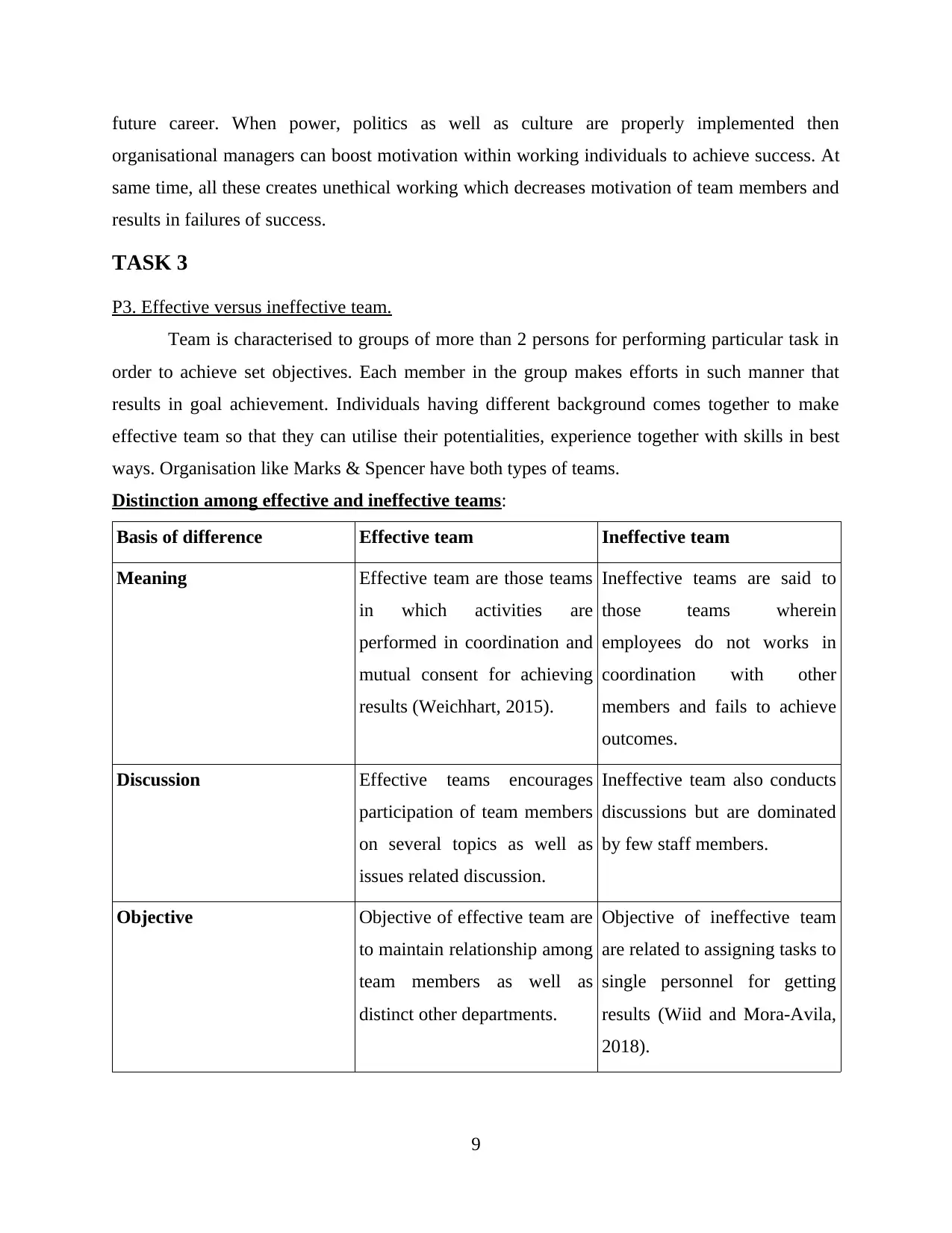
future career. When power, politics as well as culture are properly implemented then
organisational managers can boost motivation within working individuals to achieve success. At
same time, all these creates unethical working which decreases motivation of team members and
results in failures of success.
TASK 3
P3. Effective versus ineffective team.
Team is characterised to groups of more than 2 persons for performing particular task in
order to achieve set objectives. Each member in the group makes efforts in such manner that
results in goal achievement. Individuals having different background comes together to make
effective team so that they can utilise their potentialities, experience together with skills in best
ways. Organisation like Marks & Spencer have both types of teams.
Distinction among effective and ineffective teams:
Basis of difference Effective team Ineffective team
Meaning Effective team are those teams
in which activities are
performed in coordination and
mutual consent for achieving
results (Weichhart, 2015).
Ineffective teams are said to
those teams wherein
employees do not works in
coordination with other
members and fails to achieve
outcomes.
Discussion Effective teams encourages
participation of team members
on several topics as well as
issues related discussion.
Ineffective team also conducts
discussions but are dominated
by few staff members.
Objective Objective of effective team are
to maintain relationship among
team members as well as
distinct other departments.
Objective of ineffective team
are related to assigning tasks to
single personnel for getting
results (Wiid and Mora‐Avila,
2018).
9
organisational managers can boost motivation within working individuals to achieve success. At
same time, all these creates unethical working which decreases motivation of team members and
results in failures of success.
TASK 3
P3. Effective versus ineffective team.
Team is characterised to groups of more than 2 persons for performing particular task in
order to achieve set objectives. Each member in the group makes efforts in such manner that
results in goal achievement. Individuals having different background comes together to make
effective team so that they can utilise their potentialities, experience together with skills in best
ways. Organisation like Marks & Spencer have both types of teams.
Distinction among effective and ineffective teams:
Basis of difference Effective team Ineffective team
Meaning Effective team are those teams
in which activities are
performed in coordination and
mutual consent for achieving
results (Weichhart, 2015).
Ineffective teams are said to
those teams wherein
employees do not works in
coordination with other
members and fails to achieve
outcomes.
Discussion Effective teams encourages
participation of team members
on several topics as well as
issues related discussion.
Ineffective team also conducts
discussions but are dominated
by few staff members.
Objective Objective of effective team are
to maintain relationship among
team members as well as
distinct other departments.
Objective of ineffective team
are related to assigning tasks to
single personnel for getting
results (Wiid and Mora‐Avila,
2018).
9
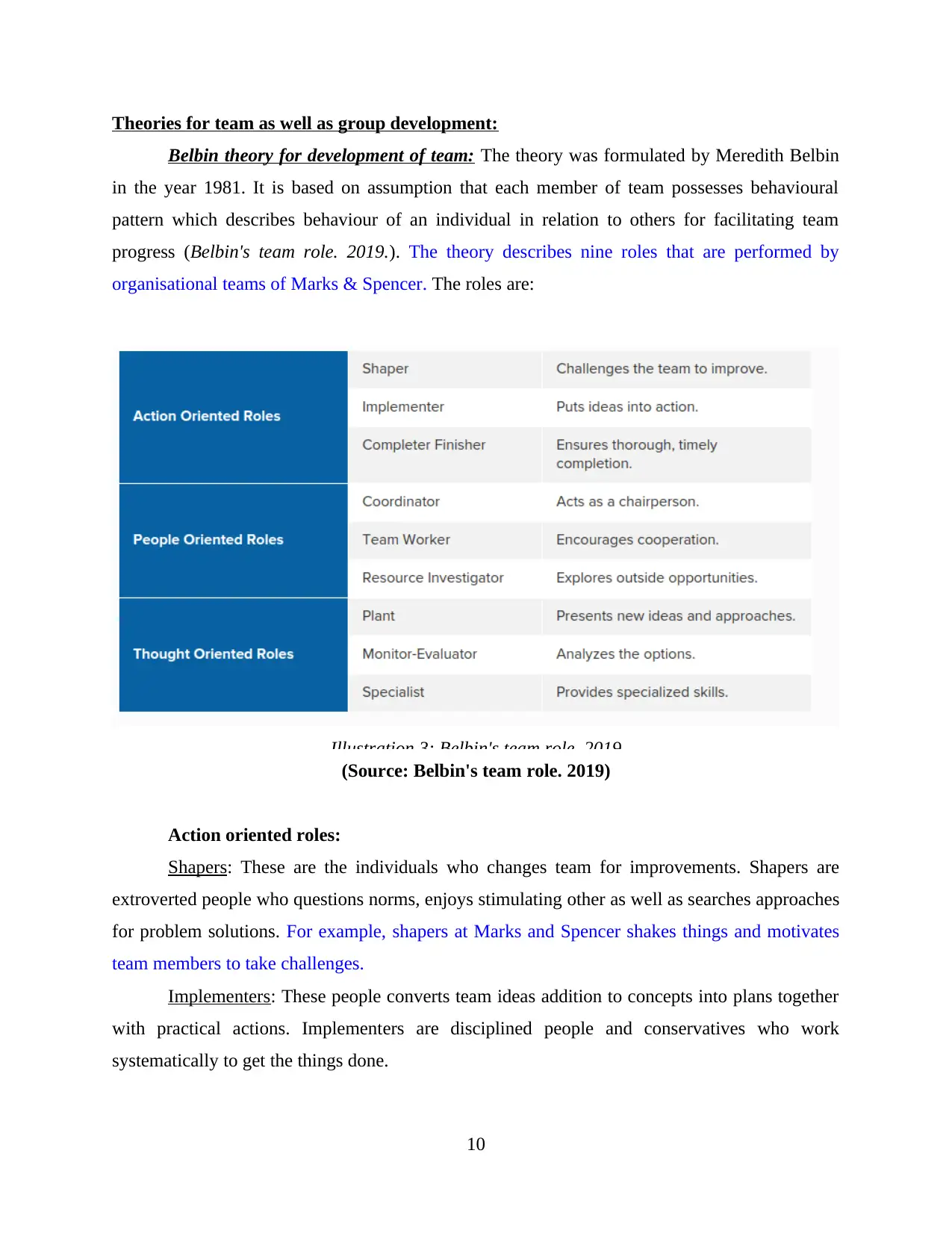
Theories for team as well as group development:
Belbin theory for development of team: The theory was formulated by Meredith Belbin
in the year 1981. It is based on assumption that each member of team possesses behavioural
pattern which describes behaviour of an individual in relation to others for facilitating team
progress (Belbin's team role. 2019.). The theory describes nine roles that are performed by
organisational teams of Marks & Spencer. The roles are:
Illustration 3: Belbin's team role. 2019
(Source: Belbin's team role. 2019)
Action oriented roles:
Shapers: These are the individuals who changes team for improvements. Shapers are
extroverted people who questions norms, enjoys stimulating other as well as searches approaches
for problem solutions. For example, shapers at Marks and Spencer shakes things and motivates
team members to take challenges.
Implementers: These people converts team ideas addition to concepts into plans together
with practical actions. Implementers are disciplined people and conservatives who work
systematically to get the things done.
10
Belbin theory for development of team: The theory was formulated by Meredith Belbin
in the year 1981. It is based on assumption that each member of team possesses behavioural
pattern which describes behaviour of an individual in relation to others for facilitating team
progress (Belbin's team role. 2019.). The theory describes nine roles that are performed by
organisational teams of Marks & Spencer. The roles are:
Illustration 3: Belbin's team role. 2019
(Source: Belbin's team role. 2019)
Action oriented roles:
Shapers: These are the individuals who changes team for improvements. Shapers are
extroverted people who questions norms, enjoys stimulating other as well as searches approaches
for problem solutions. For example, shapers at Marks and Spencer shakes things and motivates
team members to take challenges.
Implementers: These people converts team ideas addition to concepts into plans together
with practical actions. Implementers are disciplined people and conservatives who work
systematically to get the things done.
10
⊘ This is a preview!⊘
Do you want full access?
Subscribe today to unlock all pages.

Trusted by 1+ million students worldwide
1 out of 20
Related Documents
Your All-in-One AI-Powered Toolkit for Academic Success.
+13062052269
info@desklib.com
Available 24*7 on WhatsApp / Email
![[object Object]](/_next/static/media/star-bottom.7253800d.svg)
Unlock your academic potential
Copyright © 2020–2025 A2Z Services. All Rights Reserved. Developed and managed by ZUCOL.



